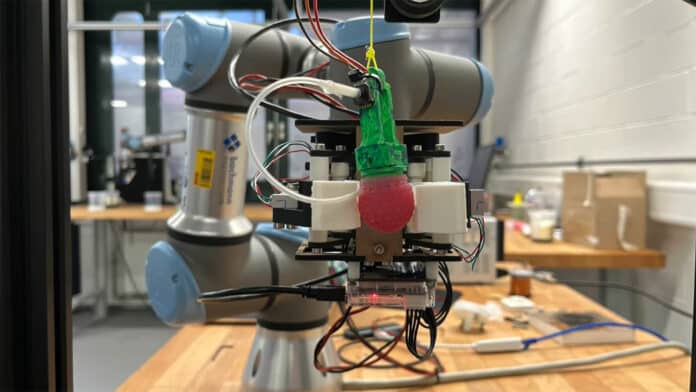Robotics has an increasing role to play in agriculture to enable the food demands of the ever-growing population to be met. One key area where robotics can contribute is fruit harvesting, which is labor-intensive and considered a relatively expensive operation. However, a key challenge is to develop robotic systems to harvest soft fruits such as raspberries which require delicate handling as they are easily damaged.
Picking a raspberry is not an easy task. You need to support the berry from below, grasp it gently between your thumb and index finger, then pull carefully until it detaches from the receptacle and falls into the palm of your hand.
To help harvesting robots get accustomed to this task, the engineers at EPFL‘s Computational Robot Design & Fabrication (CREATE) lab designed and built a silicone raspberry that can help teach harvesting robots to grasp fruit without exerting too much pressure. The silicone raspberry can tell the robot how much pressure is being applied, both while the fruit is still attached to the receptacle and after it’s been released.
The fake raspberry’s properties can be adjusted to simulate the resistance of the fruit and require the robot to exert the necessary picking force. Thanks to this, robots can train to harvest the fruit without damaging it.
“Our sensorized raspberry, coupled with a machine learning program, can teach a robot to apply just the right amount of force,” explains Ph.D. student Kai Junge. “The hardest part is training the robot to loosen its grip once the raspberry detaches from the receptacle so that the fruit doesn’t get squashed. That’s hard to achieve with conventional robots.”
CREATE’s replica raspberry is made from silicone, and its receptacle is from 3D-printed plastic. It also contains a fluidic sensor consisting of a soft silicone tube to measure the compression force applied by the robot.
Now, the lab has designed and tested their harvesting robot based on a new idea. The robot is little more than a gripper with two 3D-printed fingers covered with a thin layer of silicone and attached to a robotic arm. It uses graspers for picking and cameras and software to feel raspberries and see where they’re located and whether they’re ready to be harvested.
The team demonstrated the proof of concept for their design and carried out a series of tests, first picking the replica raspberry by hand and then using the robotic system. The team says the technology itself needs to be more mature.
Early field demonstrations achieved an 80% harvesting success rate without any modifications to the lab-trained robot.
Journal reference:
- Kai Junge, Catarina Pires, and Josie Hughes. Lab2Field transfer of a robotic raspberry harvester enabled by a soft sensorized physical twin. Communications Engineering, 2023; DOI: 10.1038/s44172-023-00089-w
